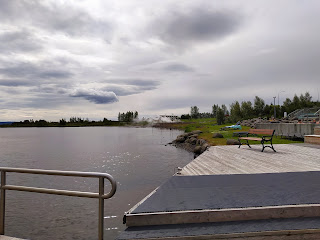 Visit to the swimming pool on the weekend
Visit to the swimming pool on the weekend
After we had rather modest weather on Friday and Saturday, first rain and then a lot of wind, yesterday on Sunday it was dry again and almost no wind, so we took advantage of the good weather to spend the day comfortably in the swimming pool - in this case in Fontana in Laugarvatn, located directly on Lake Laugarvatn.
Christianization of Iceland - baptism in warm water When the Christianization of Iceland was decided in the year 1000 (under pressure from the Norwegian King Ólafur Tryggvason) at the Alþing in Þingvellir on the advice of the law speaker Þorgeir Þorkelsson and the country's chiefs had to be baptized, the water in Þingvellir was far too cold for them, so The noblemen rode around 25 km to Laugarvatn to be baptized in the warm Vigðalaug spring on the shore of the lake in more pleasant temperatures.
 |
| Lögberg, Thingvellir |
Laugarvatn - hot springs on the lake There are three hot springs next to each other on the shore of Lake Laugarvatn. The coldest spring is Vigðalaug, where the Viking chiefs were baptized, the middle spring is used for the swimming pool in the town of Laugarvatn on the shores of the lake of the same name. The third and hottest spring is used by the municipality of Blaskogabyggd for heating the public and private buildings in the municipality.
Swimming pool in Laugarvatn The hot springs and steam here at the lake have been used by the residents of Iceland for a long time. Baths were built near Laugarvatn in 1929 and were in operation until 2007.
The current swimming pool was opened in 2011.
There are three different pools and a hot pot (pictured here on the right) with a temperature of around 39° with a beautiful view over the lake and the volcanoes and glaciers behind it.
By the way, the swimming pool is very proud of the fact that the steam baths here can be operated directly with the vapors of the geothermal energy flowing from the depths through grids in the floor. There are three steam baths with different temperatures, as well as a small sauna.
Access to the lake
A special attraction of the swimming pool for me is that there is access to the lake. Two wooden footbridges lead past warm signs into Lake Laugarvatn and you can (at your own risk) swim directly into the lake and here.
As beautiful as it is - despite the hot springs on the shore, I found the lake here to be ice cold!
My husband was braver than me and swam a bit in the lake. If you seriously wanted to swim in the lake, you had to come in a wetsuit!
Sumartilboð - Summer special offer due to Corona
After the Corona-related closure of all swimming pools in Iceland, the Fontana Laugarvatn has now been open again since May 28, 2020. And there is a summer special offer (currently limited until August 31, 2020).
Instead of 3,950 ISK (around €25), entry for an adult this summer only costs 2,000 ISK (around €12.50). Young people aged 13 to 16 currently only pay 1,500 ISK instead of 2,000 ISK. Children under 13 years of age accompanied by an adult are free.
Have a good meal!
After the swimming pool, we and our youngest went to Krambúð in Laugarvatn, right next to the gas station, and treated ourselves to the "family offer" of burgers, fries and a 2-liter bottle of Coke.
[Translated from
here.]
 Here's a quick recipe for cinnamon rolls that I baked for the weekend - without yeast, which takes a long time to rise, but with baking powder and thick milk/sour milk.
Here's a quick recipe for cinnamon rolls that I baked for the weekend - without yeast, which takes a long time to rise, but with baking powder and thick milk/sour milk.

























































